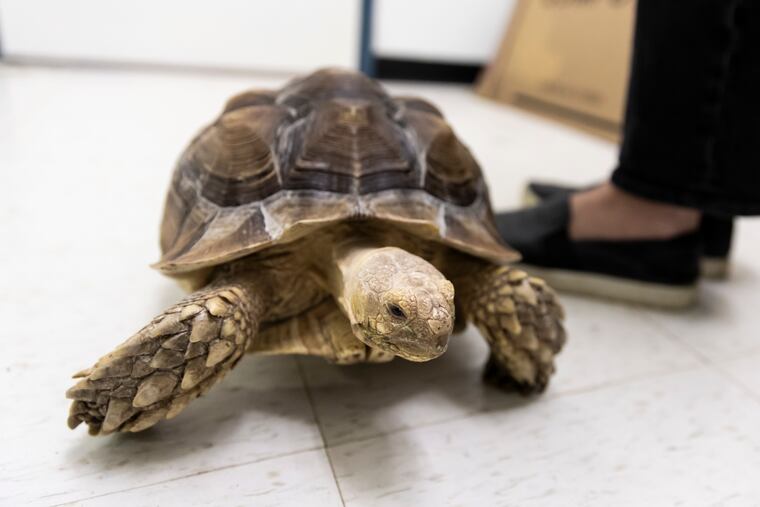Two tortoises were abandoned in North Philly then given a new home
The pair — a 15-pound Sulcata and a two-pound Russian tortoise — had been dropped off in a box at the nearby ACCT Philadelphia shelter. They'd been well-cared for.

Nearly victims of the Philadelphia winter, two tortoises abandoned in an alley in North Philadelphia were found and rescued Tuesday evening.
The pair — a 15-pound Sulcata and a two-pound Russian tortoise — were dropped off in a box at the nearby ACCT Philly shelter, according to Sarah Barnett, the executive director of the nonprofit, also known as the Animal Care & Control Team.
Barnett said that the person who found the animals was not the owner.
“The tortoises were in good shape,” Barnett said. “A lot of times people will bring in tortoises whose shells are flaking or falling apart,” indicative of an improper diet.
Someone had been treating the dark-and-light-tanned tortoises well, feeding them fruits and vegetables and keeping the animals — native to warm climates — under 80- to 90-degree heat lamps, Barnett said. Sulcata tortoises are native to the Sahara desert; Russians come from regions near Pakistan and Iran.
“They would have died in the cold,” she added. “It’s unusual for such well-cared-for animals to be dumped in an alley.”
Displaying a “curious, friendly nature,” the Sulcata tortoise, a male that’s possibly 2 years old, was eating out of people’s hands on Wednesday. The Russian, whose sex hasn’t been discerned, was not so calm.
“It’s a little bit of a bully and chases the larger tortoise, trying to bite him,” Barnett said.
‘They will be taken care of’
Throughout the day Wednesday, the ACCT was disseminating information about the animals on social media, hoping an owner would come forward.
On Thursday, the nonprofit will be ready to release the animals to a potential adopter, already lined up, Barnett said.
“They will be taken care of,” she added.
Land animals (as opposed to mostly water-inhabiting turtles), tortoises can live long lives — the Russian 40 to 50 years, the Sulcata 70 years or more.
The Russian tortoise is a “threatened” species, meaning it’s likely to become endangered within the foreseeable future, according to the U.S. Geological Survey. The Sulcata tortoise is considered “vulnerable,” facing a high risk of extinction in the wild, according to the World Wildlife Fund.
While it was a mystery where the North Philadelphia tortoises had been living, Barnett said that a surprising number of people tasked with animal-sitting someone’s pet will relinquish the job and bring them into the shelter, unwilling or unable to attend to them.
“We say to the owners, ‘You might not want to leave the animal with that friend or relative again,’” Barnett said.
Regarding the tortoises, she added, “Part of our concern is that somebody was watching them and just put them outside. There’s been a failure somewhere, some kind of disconnect. You just can’t put an animal out. They can’t suddenly become wild animals and fend for themselves.”
Barnett said that she’s witnessed a great deal of animal neglect in Philadelphia, and it’s heartbreaking.
“There’s a desensitization toward cruelty and neglect of animals in this city,” she said. “I just don’t understand.”